Hoping to learn about the Electric Blue cichlid? Since there are many different types of Electric Blue cichlids they don’t share the same scientific name.
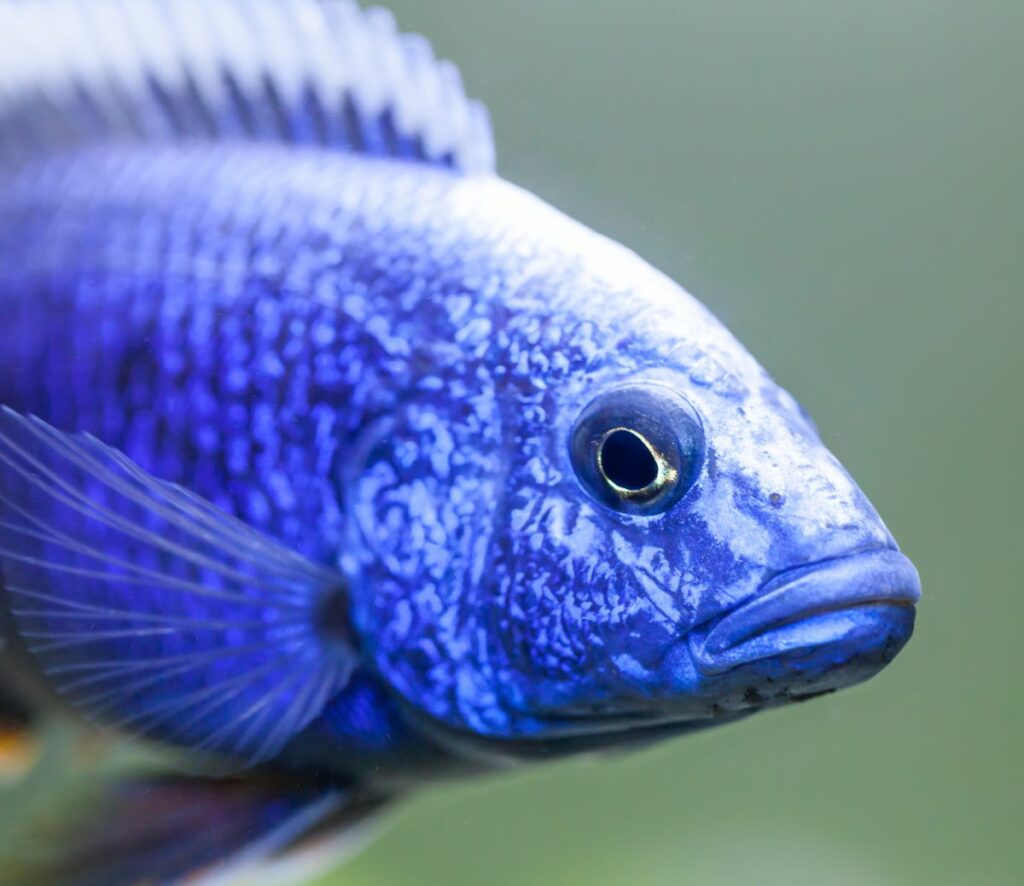
Some are found in South America while others come from Africa. Some are small fish while others are rather large. But all of them have the radiant blue colors that make them so appealing to fish keepers.
What are Electric Blue Cichlids?
There are many members of the cichlid family that go by the name “electric blue cichlid” in the aquarium hobby. But not all of them have these colors naturally. Light blue is a common shade in the aquarium hobby, however it can be quite dangerous in nature.
Radiant blue tones will make it easier for predators to pick off fish if they stand out in their environment. Therefore many cichlids have subdued colors to keep them from being eaten. Unless they are breeding, in which case most other species of cichlids are quite colorful.
Breeders looking to create new varieties for the home aquarium have, over the years, chosen cichlids that have brighter colors than average. They then breed these fish together, creating babies that often have brighter tones.
These fish fry are then bred with other bright colored fish fry, further increasing their colors. In this way, we end up with electric blue cichlid varieties.
The Electric Blue cichlid types that are captive bred are the Texas Cichlid, Blue Acara, Jack Dempsey, and Blue Ram. The other Electric Blue cichlids on my list are naturally a deep blue and are all African cichlids.
Different Electric Blue Cichlid Species
From the large and predatory Electric Blue Hap to the small and mild Electric Blue Ram, there are many cichlids to consider here. If blue is your favorite color then you’re in luck because any of these fish will liven up your tank.
Electric Blue Texas Cichlid
As their name suggests Texas Cichlids are the only species of cichlid found in the United States. All of the rest are found further south or in far-off places like Africa.
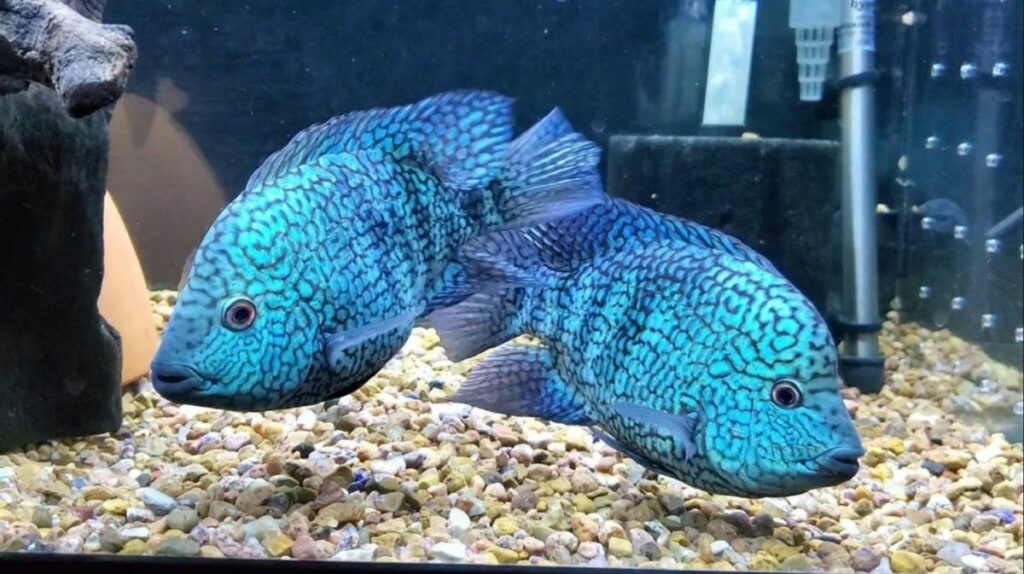
The Electric Blue Carpintis Texas Cichlid (Herichthys carpintis) is a related species found only in Northern Mexico. It has larger faint blue spots than the regular Texas Cichlid, giving it an almost solid blue color.
These fish are not too aggressive for cichlids unless they are breeding. Then even one male will turn into a terror, harassing the other fish to protect the eggs and fry laid by his partner. A separate breeding tank is recommended when keeping a pair of Electric Blue Texas Cichlids.
Electric Blue Jack Dempsey
The Jack Dempsey is a large cichlid from Central America that are covered in light blue and gold scales. But the Electric Blue Jack Dempsey cichlid is even more beautiful. It is covered in blue spangles and black spots, with a bright red eye.
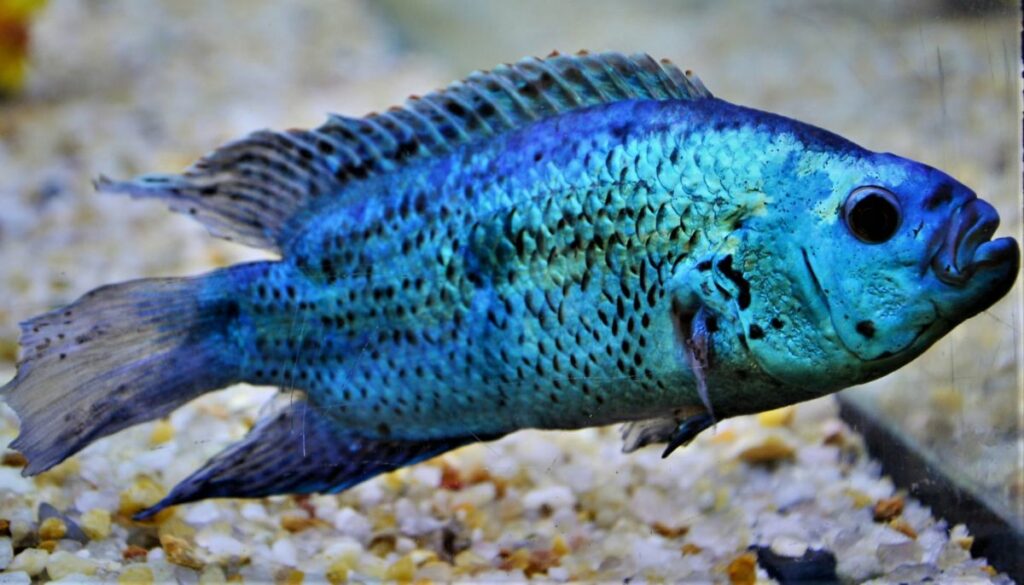
Since Jack Dempseys grow to be up to 10 inches long you need an aquarium setup that provides enough room. 55 gallons is a good minimum tank size but 75 gallons is more comfortable for just one male.
Jack Dempseys are very hardy fish. But the Electric Blue Dempsey is a little sensitive at times because it took a lot of inbreeding to achieve those bright blue cichlid colors. Regular water changes to remove ammonia and other waste products will keep your Electric blue cichlids healthy and long-lived.
Electric Blue Peacock
Peacock cichlids (Aulonocara sp.) are some of the most popular Electric Blue cichlids around. Unlike rock-dwelling Lake Malawi cichlids, peacock cichlids prefer sifting through a sandy substrate. They feed on small invertebrates like worms and shrimp that live in the sand.
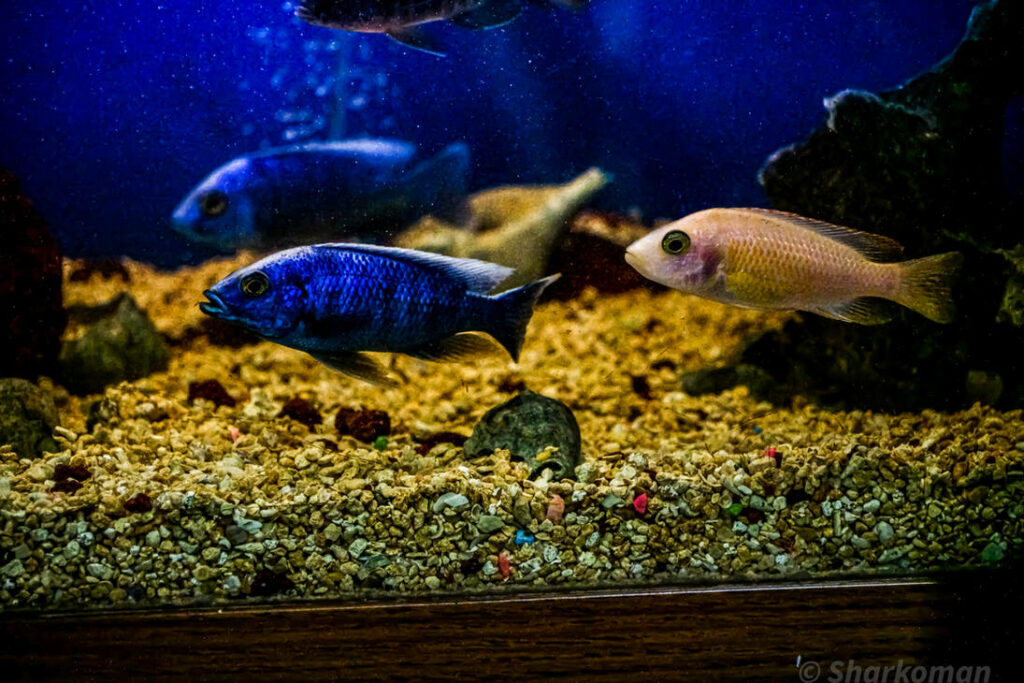
As Lake Malawi Electric Blue cichlids, they should be kept in hard, alkaline water. Water movement should be slow. And the water temperature should be between 72-80°F. Regular water changes also help these vibrant freshwater fish look their best.
Electric Blue Peacock cichlids are also one of the easier Lake Malawi species to breed. When breeding they gather the eggs into the mouth of one of the parents. By mouth brooding the eggs and fry are protected from predators until they are large enough to fend for themselves.
To prevent breeding stress it is best to move the mouth-brooding couple to a separate tank. Otherwise their tank mates will try and eat the babies when the parents are distracted.
Electric Blue Acara
From South America comes another Electric Blue cichlid: the Blue Acara (Adinoacara pulcher). It is related to the more famous and aggressive Green Terror. But the Electric Blue Acara cichlid fish is not much of a terror. It gets along well with other fish in a medium sized community tank.
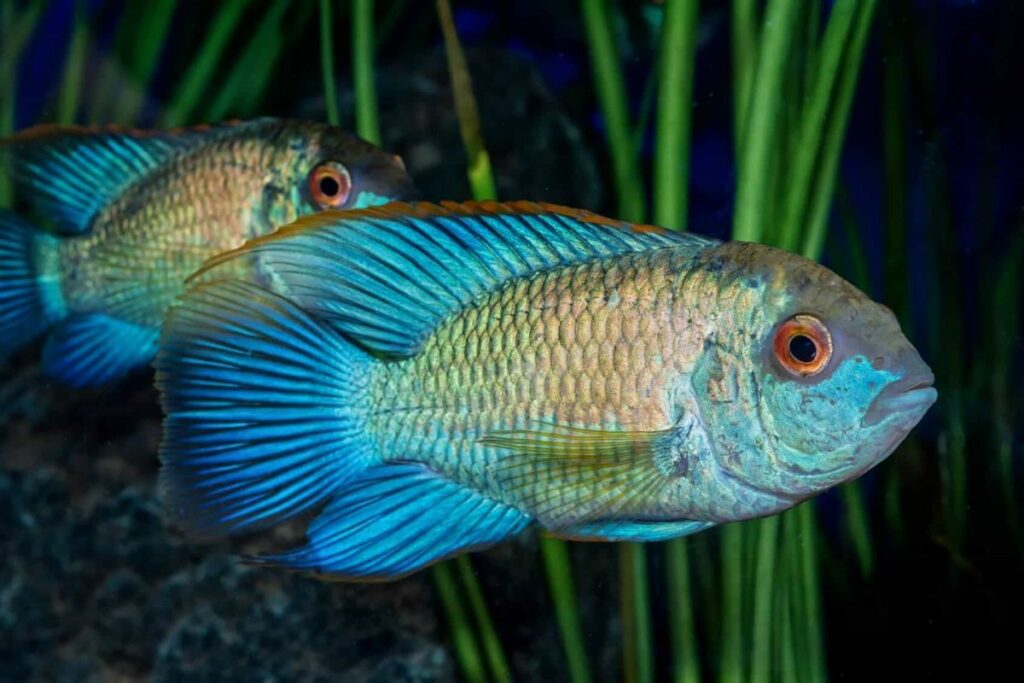
If you want to learn more about this fish here is a care guide about the Electric Blue Acara. We go into detail on choosing tank mates, feeding, and breeding.
Electric Blue Hap Sciaenochromis fryeri
Electric Blue African cichlids are as strong colored as any marine reef fish, as the Blue Hap proves. Unlike peacock cichlids and other non-mbuna this is a more aggressive species.
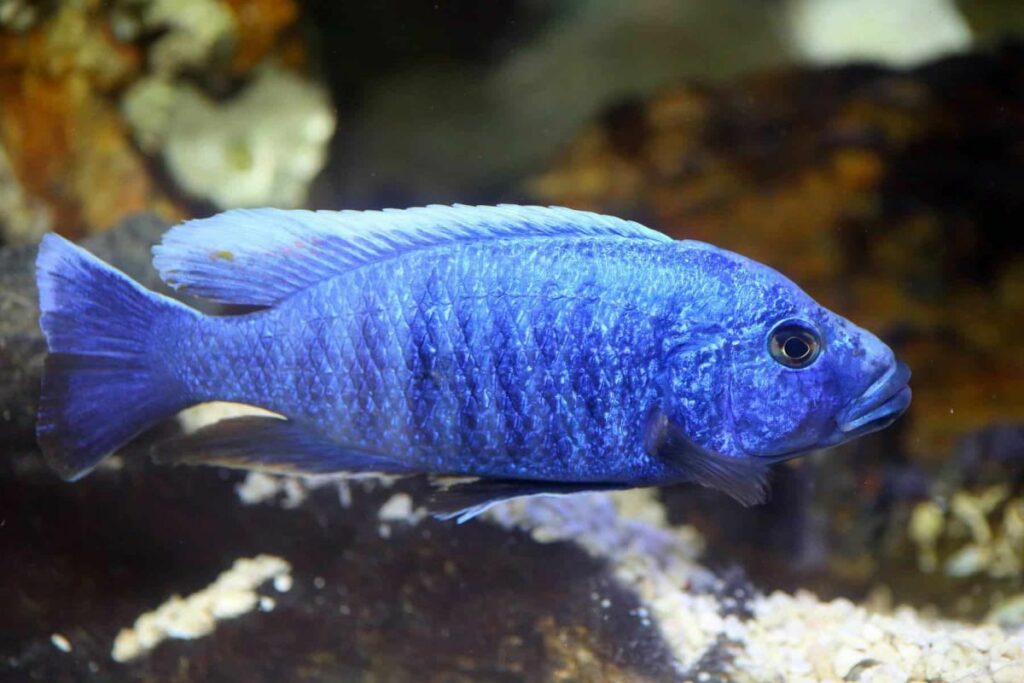
They are predatory as well, feeding on small fish. The elongated body helps them streak through the water in a rapid burst of speed and power.
If you do offer your Electric Blue Hap Sciaenochromis feeder fish, only choose healthy specimens. Poor quality feeder fish can pass on parasites and bacteria to the aquarium fish that eat them.
There is another related species to Sciaenochromis fryeri; S. ahi, which is also sold as the Electric Blue Hap. S. ahi grows even larger, up to 8 inches long. But proper care for this predator is the same as for Sciaenochromis fryeri.
These freshwater fish are found only in Lake Malawi, one of the largest lakes in the world. African cichlids are some of the more aggressive species of freshwater aquarium fish. So choose tank mates to ensure they won’t get picked apart, including smaller fish.
Crushed coral is recommended for an African cichlid aquarium. While they are freshwater fish, they need water with higher pH levels (pH 7.0+). Crushed coral helps buffer the aquarium water chemistry towards alkalinity and hardness.
Electric Blue Ram
The Electric Blue Ram Cichlid is one of the newer varieties of the ever-popular Mikrogeophagus ramirezi. But it is already an aquarium favorite as it has more intense blue colors than any other kind of Ram Cichlid.
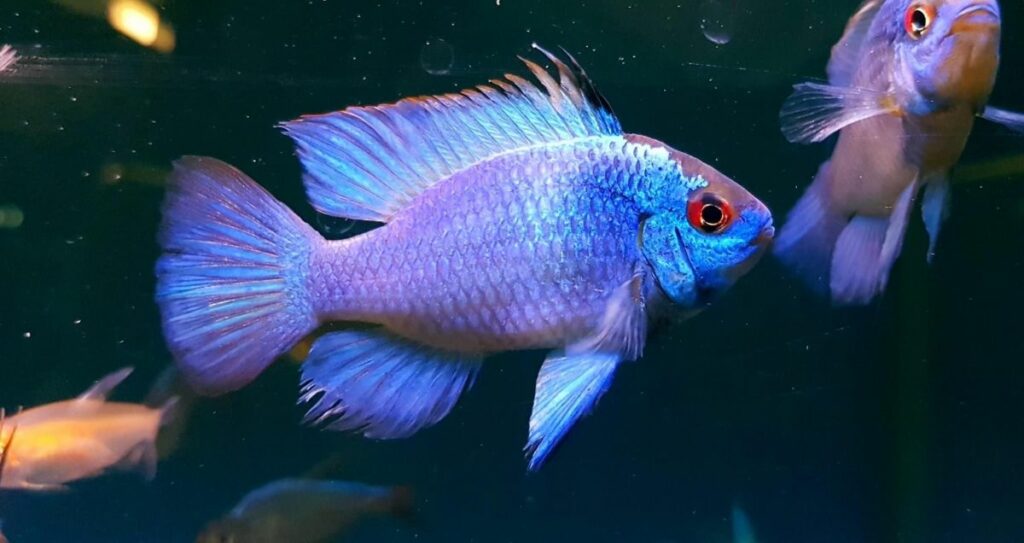
An Electric Blue Ram dwarf cichlid is great for people that want a cichlid but don’t have much space for a large aquarium. Many of the fish in this list need an aquarium 40 gallons or larger in size. But Blue Ram males do not grow larger than 2.5 inches, making a 20 gallon aquarium comfortable for a pair.
Electric Blue Johanni
The Electric Blue Johanni (Melanochromis johanni) is another African cichlid from Lake Malawi. And like all Malawi cichlids it needs alkaline water conditions in its aquarium.
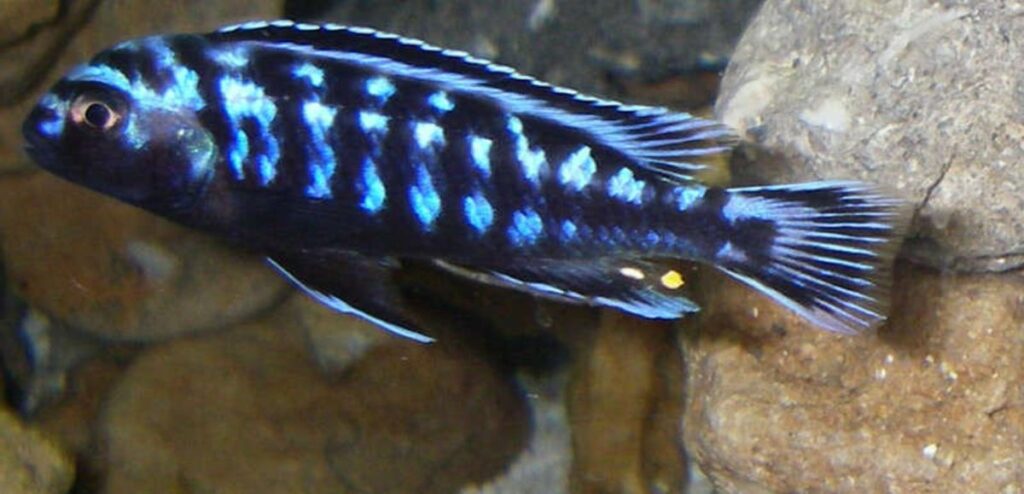
The Electric Blue Johanni is an mbuna, or rock-dwelling cichlid. These fish are analogous to marine coral reef dwellers, living in crowded communities with other cichlids. Mbuna are very aggressive cichlids since they are always competing for space.
But you can keep them in large groups with other fish of different or the same species. Other mbuna are the most compatible tank mates, including the Electric Yellow Cichlids (Labidochromis caeruleus) and the Zebra Mbuna (Maylandia zebra).
Mbuna like the Electric Blue Johanni are also vegetarian. They feed on the algae that grows on rock surfaces in the shallow, sunny waters of Lake Malawi. So any quality cichlid pellet containing spirulina or kelp should be the foundation of their diet.
Conclusion
Choosing Electric Blue cichlids is a little more complicated than you might have expected. Since each of them are quite a different fish, everything from tank mates to tank size is different.
Some will eat brine shrimp while others are vegetarian. But all are bold, eye-catching fish with plenty of cichlid personality.
More Frequently Asked Questions About Electric Blue Cichlids
Still hoping to learn more about Electric Blue cichlid species? Then here are a few frequently asked questions I get about these fish.
Most cichlids are carnivorous, feeding on invertebrates, small fish, and insects. They will eat most prepared foods that are rich in protein. But rock dwelling mbuna, like the Electric Blue Johanni, are vegetarians that eat algae. So offer then vegetarian based pellet or flake formulas instead.
How aggressive an Electric Blue cichlid is depends on the species in question. Some, such as the Electric Blue Hap of Lake Malawi, are territorial and quite aggressive. But others, including the Electric Blue Acara, are mild mannered and gentle towards their tank mates.
Tank size is an important thing to consider when picking a cichlid variety. Smaller fish like the Electric Blue Ram can live in a 20 gallon tank. Larger species like the Electric Blue Jack Dempsey need a 55 gallon tank or larger to be comfortable.

